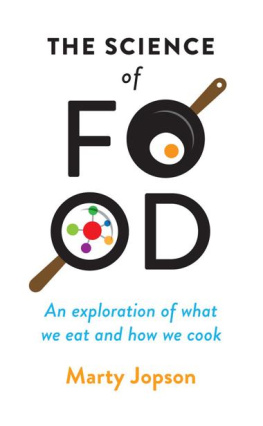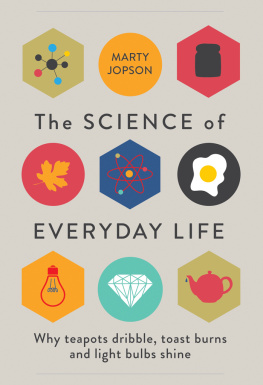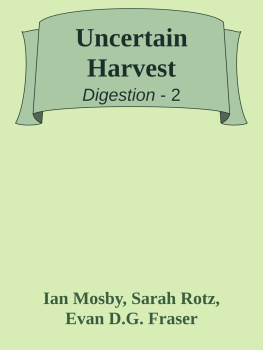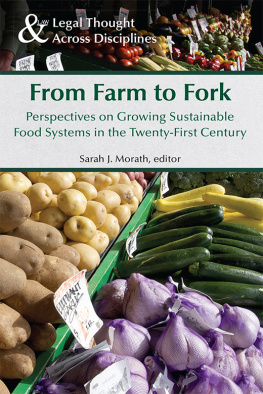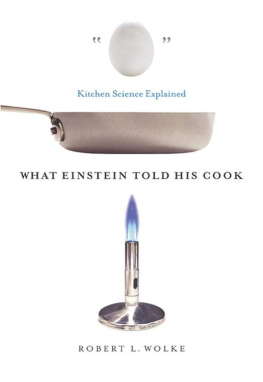Also by the same author
The Science of Everyday Life
First published in Great Britain in 2017
by Michael OMara Books Limited
9 Lion Yard
Tremadoc Road
London SW4 7NQ
Copyright Marty Jopson 2017
All rights reserved. You may not copy, store, distribute, transmit, reproduce or otherwise make available this publication (or any part of it) in any form, or by any means (electronic, digital, optical, mechanical, photocopying, recording of otherwise), without the prior written permission of the publisher. Any person who does any unauthorized act in relation to this publication may be liable to criminal prosecution and civil claims for damages.
A CIP catalogue record for this book is available from the British Library.
ISBN: 978-1-78243-838-0 in hardback print format
ISBN: 978-1-78243-863-2 in ebook format
Illustrations by Emma McGowan
www.mombooks.com
For my mother,
who taught me to cook
Contents
When I was a child I learnt to cook mostly from watching my mother in the kitchen. She was a cookery teacher and even when I was not actively helping prepare the ingredients or stir the sauces, I would sit on a stool, and watch and learn. I discovered how to handle food, how to use the paraphernalia of the kitchen and how to follow a recipe. At the same time, another interest and passion was beginning to grow, but its much harder to nail down where exactly my love of science came from. I usually credit my grandfather, who sent me lots of Readers Digest encyclopaedias, and my father, who seemed happy to take me on repeated trips to the Science and Natural History museums in London. At the time, I had no idea how much of a crossover there was between food and science, although my first foray into solo cooking demonstrated this link admirably.
This is one of those oft-repeated stories that has gained a level of notoriety in my family. Its wheeled out whenever it can be used to cause embarrassment and is guaranteed to result in much eye rolling. It also highlights how an understanding of science is what makes cooking possible. For reasons that are now lost, my mother had an errand to perform and I was to be left alone for a couple of hours in the house after school. I told her I would be bored, so she said I should bake a cake. I am pretty sure she was joking and didnt really believe that I would. Once alone, I found a recipe book (a Delia Smith one) and picked out a method for Victoria sponge. Needless to say, I completely trashed the kitchen in the process of making the cake. As I recall, there was flour, egg and butter smeared all over the place, but I had helped make cakes before and confidently ploughed on regardless. I came across one major problem with the recipe: the baking temperature said 350 and our oven only went as high as 250 . I remember thinking this was odd but shrugging it off as a typo. I shoved the oven up as high as it would go and hoped the cake would cook. Some thirty minutes later, I was frustrated when I pulled the cake out to discover the outsides charred black. I must have been about ten years old, so I cant really be blamed for having no concept of imperial or SI units. Apparently, back in 1978, cookbooks only gave temperatures in Fahrenheit, and our oven only listed Celsius. Undaunted, I scraped the burnt bits off, made up some icing and drizzled it over. I even managed to return the kitchen to what I considered to be a pristine state. My mother maintains the cake was delicious, but I recall it was barely edible.
The point of this anecdote is that to make edible food it was not enough to follow a recipe. Despite my best efforts the cake was still a bit of a disaster. I had no idea that temperature could be measured on two scales or how to convert from one to the other. If I had known a bit more about the science of temperature, maybe I would have spotted my error and could have applied that knowledge to make a better cake. Cooking is about the appliance of science, whether you are aware of it or not. It is, of course, possible with no understanding of what is going on to learn to cook delicious meals, but you will be cooking by rote. If you step away from the things you know, or when things start to go wrong, you have no way to navigate back to a successful result if you dont understand the processes involved.
There is also a huge and wonderful world of science behind the food we dont prepare for ourselves. The processed food we buy from the supermarket is full of some of the most ingenious science I have ever come across. I was lucky enough to spend three years working on a television series about processed food, researching and then building machines to replicate industrial food processes. I made a processed bread machine in a dustbin, a salmon smokehouse in a cheap flat-packed cupboard and a bathtub became a milk pasteurization device. Like my early cake baking, not all of these devices were a success; my attempt to use a 1960s mangle to make shredded wheat cereal was a complete flop, and I can no longer look at a mangle without recalling the stress caused by trying to get the cursed machine to work. However, my favourite was the machine that could crack fifty eggs in one go and would then separate the yolks, all in about fifteen seconds.
I have tried in this book to capture a little bit of the science that plays such a huge role in the production of food that you find on the shelves of your supermarket and in the meals that you prepare in your own kitchen. Taken together, I hope Ive cooked up something that gives more than just a taste of the science of food.

The thin edge of the wedge
If, like me, you are a fan of gadgets you have probably accumulated a number of peculiar devices in your kitchen drawers and cupboards. I have one drawer in particular that resists being opened due to all the kitchen technology crammed into it. Some choice items contained in this recalcitrant drawer include: the milk-foaming whizzy thing that was only used twice, the wine bottle vacuum pump for half-finished bottles, and the twice-as-fast mandolin that cuts both ways and slices your fingers twice as efficiently. A quick survey of all my gadgets reveals that they generally fall into one of two types: things for preparing food and machines for cooking food.
The food-cooking machines tend to be bigger and are geared to different methods of cooking that are, on the whole, only possible with these machines. So, the slow cooker contains a thermostat without which such prolonged cookery would be impossible, and the bread machine turns the production of a loaf into a ninety-second prep-and-ignore activity. The hot-air popcorn thing is mostly retained for the amusement value of seeing the kids trying to capture puffed corn as it flies violently out of the open mouth of the machine and ricochets around the kitchen.
However, when it comes to the food-preparation devices the mandolins, peelers, crushers, dicers and chip-makers I have a sneaking suspicion that every single one of these is redundant. With a bit of practice, all of these gadgets can be replaced by a really good knife. Surely, the knife is the ultimate in kitchen gadgets; an irreplaceable tool for the cook, and the most versatile.
I have a modest collection of kitchen knives. My current favourite knife is a wonderful Japanese-style Santoku with a cherry-wood handle. It holds a beautiful edge, cuts through anything like butter and suits my cutting style. But why does a knife cut in the first place? And can an understanding of this influence knife usage in the kitchen?
Next page
